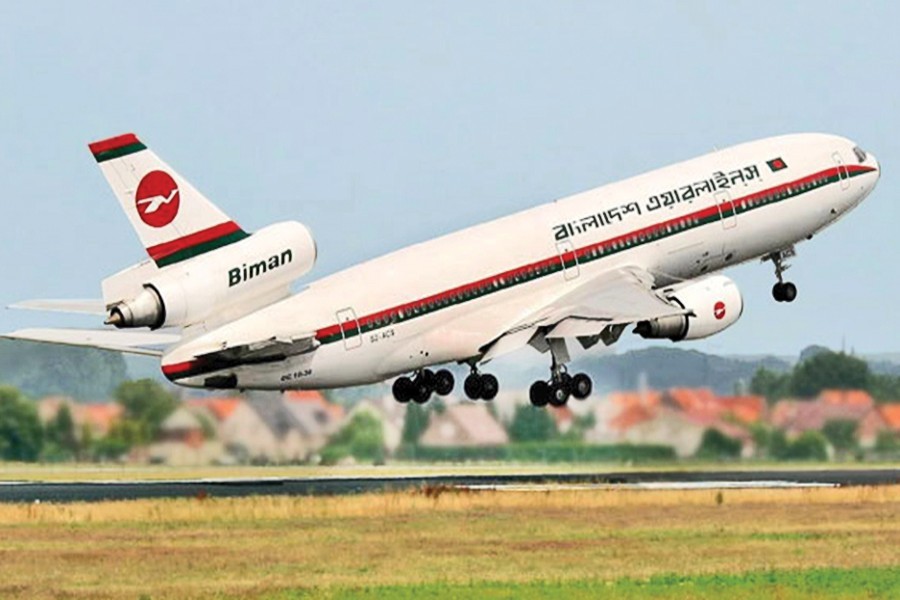With the addition of a brand new Boeing aircraft to the existing Biman fleet, a clear move is in sight to revamp the national airline. Akashbina is the first of four new 787-8s aircrafts Biman is going to have by the next year end. The second aircraft is scheduled to be delivered by November this year and the remaining two by September next year. Earlier, four 777-300ER, four 787-8, two 737-800 and three 777-300ER aircrafts joined Biman fleet during 2011 to 2014.
One has reasons to feel good insofar as procurement of aircrafts for an airline with limited network like Biman is concerned. The obvious question now: can Biman work its way out with only the new aircrafts? Indeed, aircrafts -- good aircrafts -- are the foremost requirement. But managing an airline is not limited to adding aircrafts in its fleet. It is more about other things, in that it is essentially about proactive thinking and keeping continuous vigil on scores of management-related issues. It is here that Biman, ever since it started operation, hardly ever succeeded to prove itself up to the mark. As a result, the national flag carrier has often been a cause for public outrage and a nagging frustration for the government. According to observers, Biman's constraints are too many, and sorting those for correction would call for a total overhauling of the system in which it is run.
Among the many constraints, the most commonly attributed one to alleged mismanagement and poor functioning of Biman is believed to be its manpower which far from being its strength is often a burden. While this manpower, for the most part, is alleged to lack the desired professional aptitude, the over-crowding of the employees in Biman's payroll makes it an inevitable case for having its wings clipped. At present, Biman has twelve aircrafts, of which eight are reportedly in operation. For running these eight airplanes Biman is paying salary and perks to around five thousand employees. As per international standards, one aircraft, in an ideal situation, requires an experienced workforce of not more than two hundred people. This example may sound rather simplistic to calculate the workforce Biman needs for its eight (or twelve) aircrafts. Nonetheless, it does exemplify the colossal waste of state spending.
That Biman, despite its being a critically important service provider not only to Bangladeshis but to a sizable number of foreign nationals at home and abroad, is treated like any other state-owned agencies is evident from the fact that a good number of employees presently on Biman's payroll were not at all meant for airline jobs. These employees, who originally belonged to a number of Biman's subsidiaries, were absorbed by Biman when those subsidiaries got shut down. There are strong pointers to suggest that the large pool of employees is often in a position to dictate terms to their own advantage and frustrate moves by the management which otherwise could have proved beneficial.
Burdensome manpower coupled with the lack of proper and timely planning has turned Biman into a chronic losing concern. Mismanagement is seen as the main reason for slashing down of the international routes, reportedly from 26 to 17 recently. Losses are a recurrent feature every year. Last year the loss has been estimated at well over Tk 6.0 billion.
Observers believe that given the captive routes, particularly in the Middle Eastern and Gulf countries where Bangladeshi workers do count as prospective source of Biman revenue, the national airline has been far less proactive compared to airlines such as Saudia, Emirates, Ittehad etc. Even during the Haj season when more than one hundred twenty thousand pilgrims from Bangladesh visit Saudi Arabia and return in a span of around two months, the authorities fail to cash in on the immense prospect. Chartered planes are hired but carrying such a huge number of passengers or a majority of them requires well-planned mechanism to succeed, which is not noticeable. So, the gap is filled by other airlines.
One of the accusations often raised by concerned quarters is that while expanding its international routes, Biman gives little attention to the viability as well as sustainability of such moves. This obviously results in undesirable delays and cancelled flights. It is observed that erratic flight planning causes unwarranted mechanical trouble in the aircrafts resulting in shutting down the flight schedule/s for inordinately long period of time.
Running an airline is indeed a highly technical matter. An ordinary person can at best point out the deficiencies as he or she perceives them, but can not suggest ways for improvement. It is here that managing an airline requires in the first place expertise of skilled professionals. Now that Biman is apparently set to bring improvement in its overall performance, one hopes that things will be left to professionals, if necessary, hired professionals from abroad.


